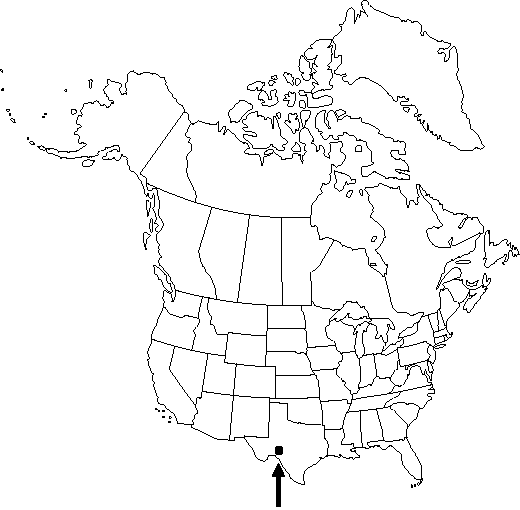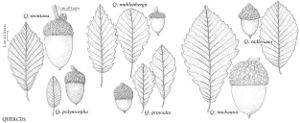Difference between revisions of "Quercus polymorpha"
Linnaea 5: 78. 1830.
FNA>Volume Importer |
FNA>Volume Importer |
||
| Line 21: | Line 21: | ||
}}<!-- | }}<!-- | ||
| − | --><span class="statement" id="st- | + | --><span class="statement" id="st-undefined" data-properties=""><b>Trees,</b> subevergreen, to 20 m. <b>Bark</b> gray to brown, scaly. <b>Twigs</b> reddish brown, 2-3 mm diam., tomentose, soon glabrate. <b>Buds</b> reddish brown, ovoid, 3-10 mm, apex acute, pubescent or glabrate. <b>Leaves</b>: petiole (6-)15-25 mm. <b>Leaf</b> blade elliptic or ovate or lance-ovate, sometimes obovate, 50-100(-150) × 30-60(-80) mm, base rounded or cordate, margins entire or obscurely or prominently serrate-toothed in distal 1/3 blade, revolute, secondary veins moderately curved, 10-12(-14) on each side, apex rounded, acuminate or retuse, sometimes with prominent drip-tip; surfaces abaxially light green, sometimes rather glaucous, veinlets raised, forming raised reticulum, floccose or tomentose with erect, golden hairs, soon glabrate, adaxially dark or light green, glossy, floccose or tomentose when immature, soon glabrate, secondary and tertiary veins impressed. <b>Acorns</b> 1-2 on peduncle 5-30 mm; cup hemispheric or funnel-shaped, 10-13 mm deep × 12-20 mm wide, including ca. 1/2 nut, scales appressed, thickened basally, gray-canescent; nut light brown, ovoid-ellipsoid or barrel-shaped, 14-20(-25) × 8-13 mm, glabrous. <b>Cotyledons</b> distinct.</span><!-- |
-->{{Treatment/Body | -->{{Treatment/Body | ||
| Line 27: | Line 27: | ||
|habitat=Riparian forest gallery, margins of thorn scrub, dry tropical forest, lower margins of oak-pine woodland, and cloud forest | |habitat=Riparian forest gallery, margins of thorn scrub, dry tropical forest, lower margins of oak-pine woodland, and cloud forest | ||
|elevation=400-2100 m | |elevation=400-2100 m | ||
| − | |distribution=Tex.;Mexico (Chiapas | + | |distribution=Tex.;Mexico (Chiapas;Hidalgo;Nuevo León;Oaxaca;Tamaulipas;San Luis Potosí;and Veracruz);Central America (Guatemala). |
|discussion=<p>This widespread species of Mexico and Central America has only recently been discovered in the United States as a small grove of trees about 30 km from the international border in Texas (B. J. Simpson et al. 1992). Quercus polymorpha is becoming available in the nursery trade in Texas and the southeastern United States. It is distinct from the superficially similar Q. splendens Née (= Q. sororia Liebmann) of western Mexico, with which it is sometimes placed in synonymy, in that Q. splendens has connate cotyledons instead of distinct cotyledons, as in Q. polymorpha.</p> | |discussion=<p>This widespread species of Mexico and Central America has only recently been discovered in the United States as a small grove of trees about 30 km from the international border in Texas (B. J. Simpson et al. 1992). Quercus polymorpha is becoming available in the nursery trade in Texas and the southeastern United States. It is distinct from the superficially similar Q. splendens Née (= Q. sororia Liebmann) of western Mexico, with which it is sometimes placed in synonymy, in that Q. splendens has connate cotyledons instead of distinct cotyledons, as in Q. polymorpha.</p> | ||
|tables= | |tables= | ||
| Line 47: | Line 47: | ||
|habitat=Riparian forest gallery, margins of thorn scrub, dry tropical forest, lower margins of oak-pine woodland, and cloud forest | |habitat=Riparian forest gallery, margins of thorn scrub, dry tropical forest, lower margins of oak-pine woodland, and cloud forest | ||
|elevation=400-2100 m | |elevation=400-2100 m | ||
| − | |distribution=Tex.;Mexico (Chiapas | + | |distribution=Tex.;Mexico (Chiapas;Hidalgo;Nuevo León;Oaxaca;Tamaulipas;San Luis Potosí;and Veracruz);Central America (Guatemala). |
|reference=None | |reference=None | ||
|publication title=Linnaea | |publication title=Linnaea | ||
|publication year=1830 | |publication year=1830 | ||
|special status=Selected by author to be illustrated | |special status=Selected by author to be illustrated | ||
| − | |source xml=https://jpend@bitbucket.org/aafc-mbb/fna- | + | |source xml=https://jpend@bitbucket.org/aafc-mbb/fna-data-curation.git/src/9216fc802291cd3df363fd52122300479582ede7/coarse_grained_fna_xml/V3/V3_36.xml |
|genus=Quercus | |genus=Quercus | ||
|section=Quercus sect. Quercus | |section=Quercus sect. Quercus | ||
|species=Quercus polymorpha | |species=Quercus polymorpha | ||
| − | |||
| − | |||
| − | |||
| − | |||
| − | |||
| − | |||
| − | |||
| − | |||
| − | |||
| − | |||
| − | |||
| − | |||
| − | |||
| − | |||
| − | |||
| − | |||
| − | |||
| − | |||
| − | |||
| − | |||
| − | |||
| − | |||
| − | |||
| − | |||
| − | |||
| − | |||
| − | |||
| − | |||
| − | |||
| − | |||
| − | |||
| − | |||
| − | |||
| − | |||
| − | |||
| − | |||
| − | |||
| − | |||
| − | |||
| − | |||
| − | |||
| − | |||
| − | |||
| − | |||
| − | |||
| − | |||
| − | |||
| − | |||
| − | |||
| − | |||
| − | |||
| − | |||
| − | |||
}}<!-- | }}<!-- | ||
-->[[Category:Treatment]][[Category:Quercus sect. Quercus]] | -->[[Category:Treatment]][[Category:Quercus sect. Quercus]] | ||
Revision as of 13:39, 27 July 2019
Trees, subevergreen, to 20 m. Bark gray to brown, scaly. Twigs reddish brown, 2-3 mm diam., tomentose, soon glabrate. Buds reddish brown, ovoid, 3-10 mm, apex acute, pubescent or glabrate. Leaves: petiole (6-)15-25 mm. Leaf blade elliptic or ovate or lance-ovate, sometimes obovate, 50-100(-150) × 30-60(-80) mm, base rounded or cordate, margins entire or obscurely or prominently serrate-toothed in distal 1/3 blade, revolute, secondary veins moderately curved, 10-12(-14) on each side, apex rounded, acuminate or retuse, sometimes with prominent drip-tip; surfaces abaxially light green, sometimes rather glaucous, veinlets raised, forming raised reticulum, floccose or tomentose with erect, golden hairs, soon glabrate, adaxially dark or light green, glossy, floccose or tomentose when immature, soon glabrate, secondary and tertiary veins impressed. Acorns 1-2 on peduncle 5-30 mm; cup hemispheric or funnel-shaped, 10-13 mm deep × 12-20 mm wide, including ca. 1/2 nut, scales appressed, thickened basally, gray-canescent; nut light brown, ovoid-ellipsoid or barrel-shaped, 14-20(-25) × 8-13 mm, glabrous. Cotyledons distinct.
Phenology: Flowering in spring.
Habitat: Riparian forest gallery, margins of thorn scrub, dry tropical forest, lower margins of oak-pine woodland, and cloud forest
Elevation: 400-2100 m
Distribution

Tex., Mexico (Chiapas, Hidalgo, Nuevo León, Oaxaca, Tamaulipas, San Luis Potosí, and Veracruz), Central America (Guatemala).
Discussion
This widespread species of Mexico and Central America has only recently been discovered in the United States as a small grove of trees about 30 km from the international border in Texas (B. J. Simpson et al. 1992). Quercus polymorpha is becoming available in the nursery trade in Texas and the southeastern United States. It is distinct from the superficially similar Q. splendens Née (= Q. sororia Liebmann) of western Mexico, with which it is sometimes placed in synonymy, in that Q. splendens has connate cotyledons instead of distinct cotyledons, as in Q. polymorpha.
Selected References
None.
